
|
| ||||||||||||||||||||||||||||||||||||||
Private walking
tours in Paris
Each walk is about
three hours long with a small break. Cultural, historic, with stops in romantic
or famous parks, guided visits in museums. Relaxed, small groups (each tour
is private: not mixed with other groups) and plenty of extra advice on restaurants,
cafés, shops, how to get around, places to see, hot performances ... Make your
stay worthwhile and get the key to understanding the city and its inhabitants.
1.
Saint Michel District - The Roman and Student Area
During
the Roman period, Paris, built on the left bank of the City,
was the biggest city in northern Europe. We will visit an old arena,
the old roman baths and other ruins remaining from that period.
You will also see the Sorbonne University and walk around the
narrow winding streets of Mont Saint-Geneviève, named after
the Patron Saint of Paris, who lived in the 5th century;
then, have a break in the Luxembourg Gardens, where the
'Rive Gauche' intellectuals take their daily stroll.
We can check out the nearby shopping area, browse through the
book stalls on the river bank and visit two old medieval parish
churches their graveyard and the oldest tree in Paris.
Arene de Lutece
Sorbonne
Mont St-Genevieve church
Jardin de Luxembourg
Odeon little streets
Musee de Cluny
Eglise St Severin and
St Julien le pauvre
2.
The Islands 'La Cité' and 'Saint-Louis' - The Middle Ages and Gothic
Art
All through the Middle Ages Paris was concentrated around the island of 'La
Cité',
closed every night with chains crossing the Seine river. Here the Notre-Dame
cathedral was built, one of the early gothic monuments, in contrast to the
Royal Chapel, which is tiny in comparison and more sophisticated in style.
Then
we can go across to the Saint Louis island, which was called 'Cow island'
('Ile des Vaches') before it was built up by bankers in the 17th century. For
Parisians
Ile Saint-Louis is a place to come for Berthillion's ice-cream with its 30 flavors.
We can rest on the banks of the river or in the Notre Dame gardens.
In the same complex as the Saint Chapelle, once the residence of the kings
of France, now the Administration and the Court of Justice, you can see the
magistrates and lawyers in their robes. We can continue our walk in many directions,
maybe along the Seine to the Pont-Neuf , past the towers where Marie-Antoinette
was imprisoned. This area is where 'The Hunchback' lived and it was used as
the
setting for the film "an American in Paris".
| Notre-Dame Ile St Louis La Sainte Chapelle the Court of Justice La Conciergerie Pont Neuf |
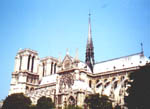 |
3. The Marais: The Parisian Renaissance and Louis XIV
With the coming
of the Renaissance Paris was remodeled to a new idea of space.
Big squares and mansions for the 'bourgeois' people were built. The old medieval
streets and gothic architecture could not be easily forgotten and we can still
see
old wood beam houses, castle-like buildings with French style gardens. The Marais
(meaning 'the Swamp') is a chic and fashionable place for antiques and shopping,
we can see the old wall which enclosed Paris in the 12th century in between,
and
have a picnic at the symmetrical Place des Vosges square, lined with its mansions
in red brick and white stone walls and high rooftops, where Victor Hugo used
to live.
There are several other private mansions with courtyards and gardens that we
can visit and or the classic style church which houses a Delacroix painting.
| rue Francois
Miron maison 'pignon sur rue' rue St Paul le mur de Philippe-Auguste Hotel de Sens Place Des Vosges, Hotel de Sully Rue Turenne hotels Eglise avec Delacroix Hotel Liberal Bruant |
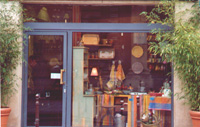 |
4.
The Tuileries Gardens and the Classic Style of Paris
| From the gardens of the Louvre, in its classical French layout, you can see the major buildings and squares: the Concord square, built during the Louis XV era, theEgyptian obelisk, the Louvre of course, the Musée d'Orsay, originally a railway station in the 19th century. In the gardens there is a labyrinth, copies of sculptures and kids can sail small boats on a pond, where a woman has been renting them out for the last 30 years. | 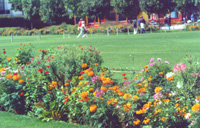 |
| We
can also visit the boutiques on the covered rue de Rivoli, where you can
find the English bookstore W.H. Smith and have a super-de-luxe chocolate at the famous Café Angelina. We can walk up to the Opera and the Place Vendome, where the Ritz hotel receives the famous and very rich and where one can find the most beautiful jewelry stores. Louvre Jardin de Tuileries Concorde rue Rivoli place Vendome avenue de l'Opéra |
|
5.
The Covered Passages; Paris of the Empire Period
A perfect idea
on rainy days and beautiful during Christmas season. A series
of 3 covered passages, lined with quaint boutiques, one specialized in second
hand art books. They were built at the end of the 19th century. Built before
the invention of electricity these covered passages make use of glass roofs
which gives it its special atmosphere. Passing the Stock Exchange market
we can walk over to the gardens of Palais Royal, where there is a covered walk
way along
the sides. In the afternoon we can see mothers with their children
or young lovers strolling in the French-style gardens. At the other end is the
Comédie Française and its café. Then across the street is the Louvre and we
can peep in from the streets into the Monumental French 17th sculpture wing
and end our
tour in front of the entrance of the Louvre.
Les passages
Bourse
Jardin de Palais
Royal Louvre
6.
Les Halles Paris Old and New
The French central
market had to be torn down and moved out of Paris in the sixties.
It was then completely restored and is now a modern shopping complex center
in the form
of a white cascade and a garden and a merry go-round. Nearby is the George Pompidou
Center, housing Modern Art. The old and the new are in constant contrast, as
the
Stravinsky water pond with mobiles created by Nicky de St Phalle and Tinguely
on a
background of the gothic church of Saint-Merry. We could either walk the chic
Faubourg
Saint-Honoré with the high fashion designers boutiques and/or walk the market
street
of rue Montorgeuil, with its cafés and foodstalls.
| Faub. St Honoré
Les Halles Fontaine de Stravinsky Beaubourg Les Halles St. Eustache rue Montorgeuil |
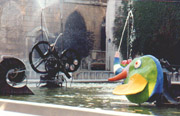 |
| From west to east we can follow the flow of the Seine river and see its history; the Eiffel Tower, the Alexander III bridge with on either side the Invalides and the 'Grand' and 'Petit' Palaces, the Orsay museum and the Tuileries Gardens and then the Louvre, the Medieval Towers of the 'La Cité' island with the bookstalls on the leftbank and the busy Parisian life and then on into the calm again by the Botanical Gardens and the Arab World Institute. Still further on lies the latest architectural works of the Ministry of Finance and Mitterand's National Library. We can alternate walking with a drive on the city's boatbus, tourist boat or several city buses. | 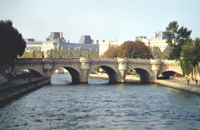 |
Montmartre, the
'mount of Martyrs', is named thus for the martyr's march
of Saint Denis, in the early days of Christianity. At the end of the 19th century,
in the crazy days, Picasso, Toulouse-Lautrec, Gauguin hung out in the cabarets,
while Montmartre was a little village, with vegetable gardens and windmills
(two are still there). You can still have a feel of the 'old Paris' here. On
top of
the hill the church of the Sacred Heart overlooks the whole of Paris. At the
artist's
square you can have your portrait done, sit at a café and eat a traditional
crepe (pancake).
| Musée d'Art
Primitif Sacré-Coeur Basilic Painters square the Old Vineyard 2 little gardens Moulin rue Lepic Place du Bateau Lavoir rue Des Abesses rue Des Trois Frères ou Yvon-le-Tac |
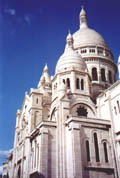 |
[back
to top]
Each walk is about
three hours long with a small break. Cultural, historic, with stops in romantic
or famous parks, guided visits in museums. Relaxed, small groups (each tour
is private: not
mixed
with other groups) and plenty of extra advice on restaurants, cafés, shops,
how to get
around, places to see, hot performances ... Make your stay worthwhile and get
the key to
understanding the city and its inhabitants.